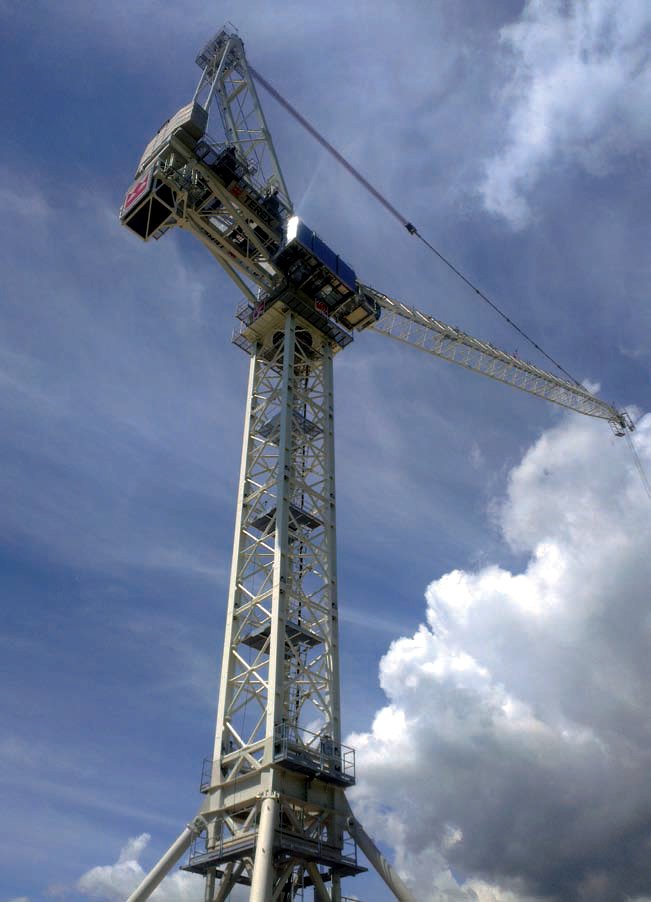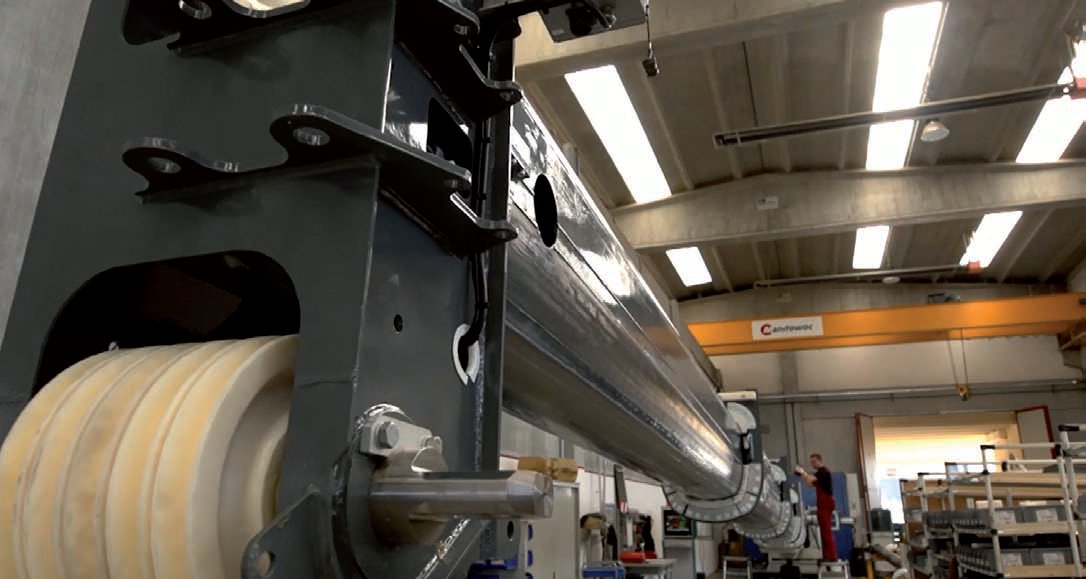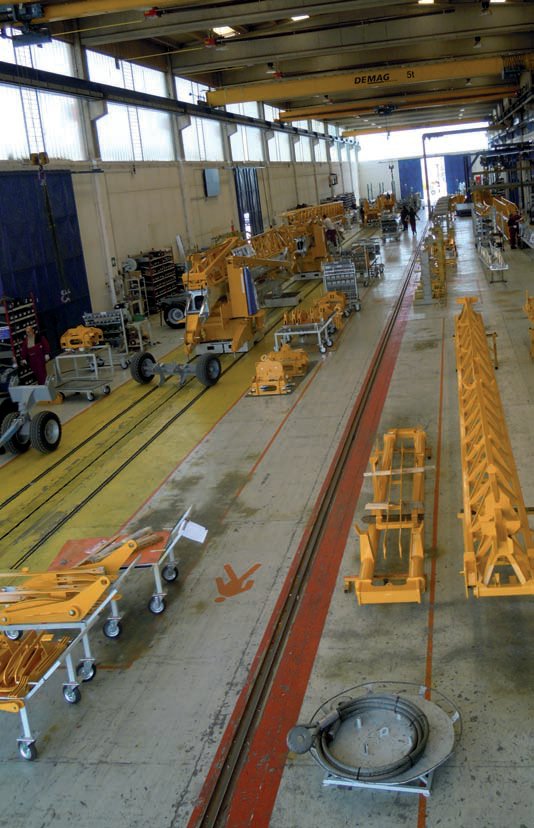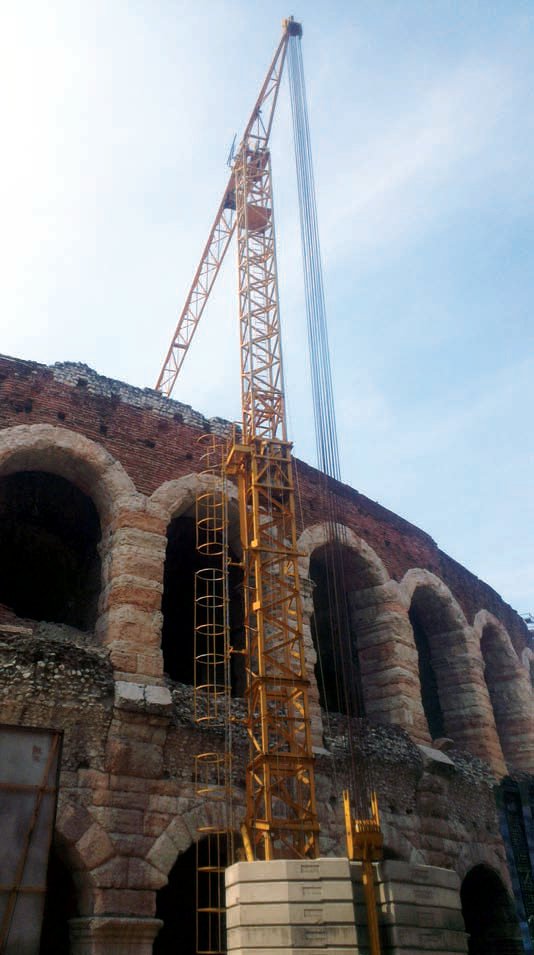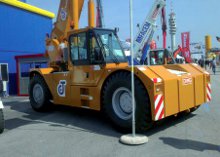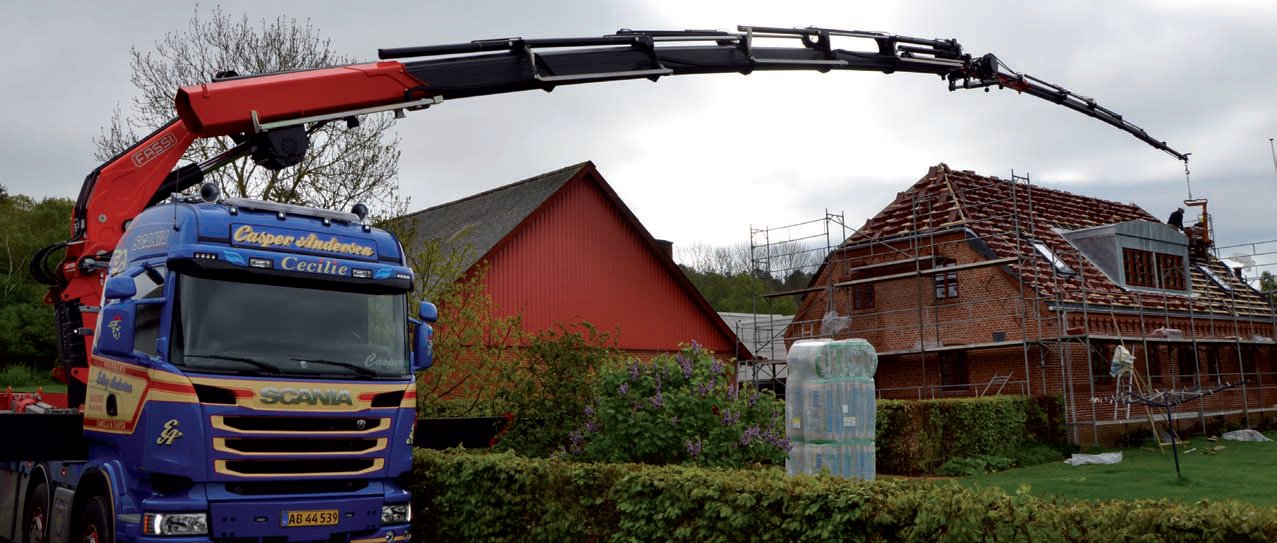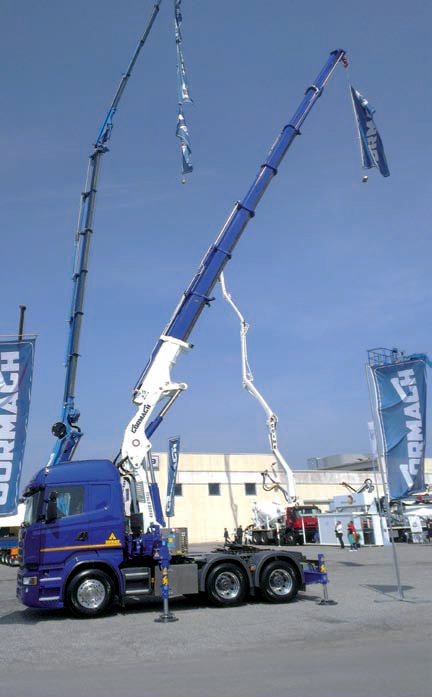Rising above the ruins
31 July 2014Italy has a long and proud history of crane-building and was for many years one of the world’s leading markets for both rough terrains and tower cranes. Today though, it’s domestic market is decimated and crane builders are having to look for new opportunities. Will North visited some of these and Samoter in Verona.
As Cranes Today toured Northern Italy visiting crane manufacturers in the region's industrial belt one thing was clear: domestic and regional Southern European sales have in not significantly impro ved since the global financial crisis.
Lean times
The first stop in our tour was Niella Tanaro Manitowoc's Italian rough terrain, small all terrain and tower crane plant an hour's drive from Milan. Much of the tradtional market for these products has been as badly hit for Manitowoc as it has been for everyone else.
However, the plant has worked with others around the world to develop products for a wider market aiming to build on its position as one of the group's pioneers in lean manufacturing and other advanced production techniques.
Enrico Angiolini, sales director, Southern Europe, says, " We are living in a period of uncertainty, but we have had at least a stop in the descent of the market. In the last twelve months, we've seen some growth expectation. Signs for the future are positive, more than in the past seven years. It's not a sign of recovery to go back to the good years we experienced in 2007, but some things are looking better."
Angiolini cites alternative energy as one source of growth with the emergence of solar energy in Southern Europe requiring self-erectors to install fields of photovoltaic cells. In Italy new infrastructure spending and next year's Expo 2015 in Milan may also boost demand.
Paolo Sassaroli has managed the plant at Niella Tanaro since 2011 and previously, since 2007, was business unit manager for mobile cranes. He says, "The self erector market is linked mainly to residential construction. In Italy there are not so many homes being built; the same in Spain. These were the biggest markets for these cranes.
"Now, France and Germany are running quite well. Recovery has come in the US, and often Europe follows by a few years, so we are quite optimistic for the future.
Federico Lovera is Manitowoc's EMEA product manager for rough terrain and truck cranes. He says, "We launched the RT550E, the first in our global development programme for rough terrain cranes, at Bauma. We're happy with sales, we're in line with our forecasts.
"But, those forecasts were based on traditional rough terrain markets. Instead, we're seeing lot of the sales outside of these markets, in North Europe, Singapore and Hong Kong."
Part of the success of the RT550E in new markets has been down to its development under Manitowoc's new global approach, with the design team at Niella Tanaro leading a project to combine traditional rough terrain with a longer and more powerful boom developed at Wilhelmshaven, home to Manitowoc's biggest all terrains.
Lovera says, "It combines traditional technology from Shady Grove in the USA for the carrier, with the more advanced technology used on GMK all terrains, such as the twin lock boom and our new CCS (Crane Control System). This is the first Manitowoc product with CCS, which will be future standard for all Grove, Manitowoc and Potain projects."
While CCS is the future of control systems for Manitowoc, both assisting the operator and providing a common interface and visual design for operators and engineers, it is also key to making a high tech twin lock boom work on a rough terrain.
Lovera says, "At the beginning, the twin lock, was not so easy for the operator, but CCS makes it much easier to use. It offers three configuration modes: a new boom configurator mode, where the user can just input weight of load and radius, and the machine proposes different configurations; a fully automatic mode, where the crane extends booms starting from small sections, simulating a full power boom; and traditional GMK mode, where a skilled operator chooses each boom extension."
That combination of high technology power and ease-of-use is allowing the RT550E to compete in new markets, and against smaller all terrains, particularly on long rents and where it is kept permanently for maintenance.
Later this year, the RT530E-2 and RT540E will be repowered to comply with new emissions standards,
At the same time as developing products for new market niches, the team at Niella Tanaro has been developing production processes. This is an area in which plant director Sassaroli has taken the lead.
He explains that the established network of component suppliers in the region has helped with this process, "We have a very flexible plant and people. This was the first plant in the group to implement lean.
"We have a lot of local suppliers. For towers, about 90% of components are local to Italy. We're able to manage orders direct from supplier to plant. For all mobiles, the steel structures are all local, and hydraulics largely localised. Engines and other components are European."
Sassaroli and his team have developed a series of improvements to production, all based around matching demand efficiently and effectively. After the initial implementation of lean, project Apiot (Italian for 'axe') cut the number of components on the production line, allowing for all terrains and rough terrains to be built alternately. In this system, rather than having racks of components supporting each station in the line, kits are prepared for each operation outside of the line, and brought to the machine as it is worked on. Workers move with the machine, seeing it through from start to finish, and increasing their engagement with the product.
Under a further project, rather than cranes being lifted from one station to the next as they are built, they move on a track at a constant speed, matching expected demand on the plant.
Since 2012, the plant has been working on a lean costing project, allowing it to track the cost of every process in the value stream.
Extended reach
Fassi is one of Italy's most internationally successful knuckleboom manufacturers. However, at home, it too is suffering. Silvio Chiapusso, communications manager, says, "The domestic market continues to be in crisis because the construction sector suffers the problems of the Italian financial system, in par ticular there are not loans from the banks for the activity of small to medium size enterprises. The lack of political reforms and the public debt mean there is an absence of investment in big public works."
In other traditional markets, demand is similarly restricted, Chiapusso says, "Southern Europe, one of the most important markets for Fassi, is going through a serious crisis. Greece, Spain, and Portugal are recording negative trends strictly connected to the demand reduction in the building sector. Some decreases have been recorded also in some areas of Eastern Europe."
The company's response has been twofold: new partnerships with manufacturers in new segments in Europe, and the development of innovative new products.
In August 2013, Fassi and it's French distributor Miltra acquired Marrell, which manufactures hook lifts, s kip loaders, tipper scissors and hydraulic cylinders. Later in the year, it acquired a major stake in CranAB, a Swedish company manufacturing forestr y cranes.
Chiapusso says, "Fassi, Marrell and CranAB have not changed. These investments were not intended to distort our identity. We tried to look at the very heart of the respective companies and implement actions aimed at enhancing our mutual strengths through a sharing of intents and strategies.
"We will advise on means of development. At CranAB, we will develop new cranes for handling of recycling of iron and metallic garbage, and for the timber industry. CranAB, has a very complete range of cranes for offroad vehicles, light and medium. But it doesn't have the range for trucks. So, over the next two or three years we will work with to create and offer a new range of their cranes suitable for the truck mounted sector and for the recycling sectors for metallic garbage.
"With Marrell, Miltra already offers both products together. We made the investment to permit the business to grow, using our sales network. We don't have a target for new products."
This development of its sales network, with key distributors around the world, is central to Fassi's approach.
Chiapusso says, "The important thing is subsititution [of markets in decline]. We've been in Australia a while, but sales there have grown substantially. In South America, in countries like Chile and Peru, our commerical policy is different to our competitors. We sell medium and heavy cranes for mining, not cheaper cranes for Brazilian and Argentinean construction firms. We're selling in full configuration, for major groups in the mining sector.
"We also have business in Mexico, and now, the USA is giving very important signals. Our dealer, Fascan is independent, but we have significant capital in the company, as we do in dealers in Chile and Peru.
"In the USA, our importer, and his sales network, are contacting new customers, not only in construction but also in the energy sector, and logistics transportation setup, to open new opportunities. Our importers had the luck to, exactly when the crisis started, get a US Army tender.
"We have a very important dealer in Singapore, exclusive to Fassi. From him, we have had good results. The main business for him is the sales of the Fassi cranes. He covers Indonesia, Thailand, Philippines, all only for Fassi.
"From ten years ago, our commercial policy for China has been to selling through our Hong Kong dealer. We are not interested to sell in China the cheap crane, or poor con guration of crane. To be there, means too big investment in assistance, post-sales organisation.
But the market has now only the cheaper cranes. Our choice is to offer the quality, the maximum technology, maximum configuration.
Our kind of package requires important investment, in training and supporting the market, and staying there to grow. to start only with the small crane is a risk for us, and is not in our vision."
At the same time as developing its international sales network, Fassi continues to innovate. One of the most important new aspects of its offering is the FX900 control system, which offers a 7in colour touchscreen interface to the company's EN12999compliant stability system (itself in a new upgraded version).
Enrico Guerini is director of technical training. He says, "The FX900 system offers a new 7in colour touchscreen display. That represents in a graphic way the crane as it works, with all the data that can help the operator to understand how it is working: the percent of load applied on the jib and winch, all the information that usually appears on our systems.
"It shows what is happening while the operator is stabilisng the crane. It shows how much the lateral support is extended, and as soon as the outrigger is on the ground, shows the capacity available on the working side.
"We participated in the EN12999 working group, so we know what is required. But, we don't limit ourselves to follow just what is required by the standard. With our electronic devices, we also add the other working conditions that we know can carry risks. The control of the outrigger and the crane are separated, with two different distributor banks".
Build it big
Terex's Fontanafredda plant was founded in 1962, as the home of Comedil, one of the world's most innovative top slewing tower crane manufacturers. The company was acquired by Terex in 1998. In 2001, Terex added Ferro, a self-erector manufacturer in Milan. Most recently, in 2012, it completed the acquisition of Recom, the boutique tower crane engineering business established by Comedil founder Ferruccio Moritsch.
This year, Martina Moritsch, Ferrucio's daughter, handed over leadership of Terex's tower crane business to Marco Gentilini, vice president of business integration, and now general manager, tower cranes.
Gentilini says, "In the early 2000s, we also acquired Peiner, which is strong in Germany and North America. Now, our tower portfolio includes the typical historical products in Fontanafredda, but also hammerhead, self erector and luffing jibs.
"This adds a lot of experience here, and bought in through these acquisitions. Being part of Terex there is the opportunity to use manufacturing capabilities in many different countries. This gives us flexibility to be close to customer, as needed.
"Towers is for Terex a global business. We try to manage it globally, while being local where it makes sense for manufacturing, and leverage local sales teams."
That global approach has been key to keeping the Fontanafredda plant working through the crisis.
Gentilini says, "I think in general, the Italian market for cranes is not showing meaningful improvements, and specifically for tower cranes. We estimate an overall drop of the market, of around 70% from 2009- 2013. That's a lot, we see today some positive signs of recovery and increasing demand from other geographies, but we don't see this in Italy for tower cranes."
Angelo Cosmo, tower cranes product marketing manager, adds, "Italy has a lot of manufacturers so the market share is very spread, it's not just the big brands, but also some minor players, each working very locally."
Looking across the region, Gentilini sees little positive in nearby countries: "In Southern Europe, there's been no meaningful improvement: In Spain and Greece, nothing. In France, its similar to Italy."
Cosmo adds, "We know Germany doesn't have big problems. We're not talking the numbers seen in 2006-8, but its but still much better than Italy."
Gentilini says, "It's important too to mention the UK. Across Europe, there's been better order intake over last couple of quarters. In general, tower cranes are improving substantially. Order intake is up over the last two quarters. That's encouraging."
Cosmo says, "In London, we have half of the market. In South East Asia, where luffers are common, Terex is a big brand. Europe is one thing, growing slowly. But we have markets such as Russia, Azerbaijan, South East Asia, where they have a different speed."
As Cranes Today visited the plant, Terex's latest, biggest, luffer, the 66t maximum capacity CTL 1600-66, was under testing, and senior staff from some major rental firms were visiting.
Gentilini says, "The new crane is a big step up, it's almost three times bigger than before. We're targeting large infrastructure needs for these cranes. We are really in a leadership position.
"It's been designed and developed thinking a lot about how to optimise for customer transportation and assembly time and cost. It offers quick erection, and safety during assembly. We offer tele-assistance to have support at a distance from the office. And, again, together with the product it's important to reinforce that the service team is behind it, both during erection and in product support and operations
"This is a crane that can go to global markets, anywhere there are large building infrastructure projects: in Europe, the Middle East or Far East, anywhere. That's why it's important we are able to provide support and work together with the customer, offering support engineering."
Cosmo says, "It's very important to have professional engineering. To have a company that can really help from the beginning, we have a very strong application engineering team to help with the specification needed, and job site layout."
Gentilini says, "This is not a residential product, this is needed where customers have special projects and needs a greater level of cooperation.
"We see growth, but not in residential, more on this side, of larger projects. That's where we're seeing increasing demand.
"We have a great product offering at the lower end, for residential. If there is an increase in demand, we are ready to supply. But for now we see demand picking up on the larger end."
Cosmo says, "In Russia, we see demand in the 200-250tm range; in the Middle East, 300-400tm, and in Latin America, much smaller cranes.
We have a very big range, so we direct production where it is needed." Fontanafredda is the backbone of this range. Gentilini says, "We have some local manufacturing in some countries. But this is the one factory where the whole range can be built.
We can leverage local factories for expensive to transport components like tower sections.
"We have a lot of cooperation with customers to try and understand local market needs. With the new CTL 1600, there was a lot of cooperation with some customers. But, today, we're not developing specific products for specific geographies, rather products we can sell globally."
Cosmo says, "By keeping the quality the same, we can promise the customer resale value, But in designing the crane, by taking the feedback, we can allow the crane to go here, there, there, fulfilling all local requirements."
Gentilini says, "We aim to have a common approach to product design. We're trying to more and more develop products that can meet global demands, with the ability to use modular design to incorporate specific features for different markets."
At the fair
Cranes Today's visit to Italy ended in Verona, for Samoter. In the poor economic client the show struggled leaving many exhibitors disappointed. Michele Mortarino, commercial director of rough terrain manufacturer Locatelli, summed up the mood among exhibitors: "We used to plan a big event at Samoter, but this year has been very poor. The customer presence is very poor. That represents a big limitation for all the exhibitors."
The lack of buyers at the show reflect local market conditions. Mortarino says, "It's been a very tough year. There's no strong indication of growth, neither in the US or here in Europe. We have to thank our new markets in Central African countries and the Middle East, which are offering us opportunities.
"We never planned for any big change in European market conditions. We didn't trust a lot in some southern American markets. Brazil is showing it's fragility, especially in our sector."
"But I'm very happy with the results of the last years, in spite of the general conditions, we've conquered new market share in regions we are present, such as the Gulf, Maghreb, and Central Africa.
"Thanks to this stabilty, we have the opportunity to enter new markets with new investment, in the Far East and South America.
As well as finding new markets in Africa and the Middle East, Locatelli, celebrating its 60th anniversary this year, has drawn on the resources of a new owner, partnering with other industrial companies in the same group. Mortarino says, "The technical features of our products are a big advantage in the fight against competitors. Our new owner MediaFinanziaria is a family business in Bergamo, our local city. Their sectors of activity are mainly related to oil and gas engineering projects, they're used to dealing with offshore platforms, big winches for the positioning of undersea pipelines.
"This sector is growing on a constant basis, even if individual oil and as companies are reducing investment.
Thanks to the flexibility of our group, the growth of our turnover has been constant, and is now €250m, a very positive result.
"Our policy of technical investment is the most critical factor. About 30% of group employees are in the technical department, there's been a huge investment in new products and a renewal of range.
"Our new 65t and 80t models, are the most powerful cranes in our production range. We focussed our attention on the load chart and performance of the machine.
"We plan to develop the brand by introducing bigger models, such as the 100t machine already under development."
Also at the show was Cormach, a knuckleboom manufacturer with a focus on bigger machines. Giulio de Luca, export manager, says, "We export about 95% of our cranes, and about 80% of our other equipment.
Our newest crane will be officially presented in November 2014. Our most recent new model, the 45000, is now ready for commercial sale, and has been sold in Europe and overseas.
In November we'll be launching the 575000. It's more than double the size of our latest model, and is designed to installed on five- and six-axle carriers. It's for niche market customers, who are doing heavy equipment movements inside factories, for example. They'll be able to use it for big press installations inside factories. It has a lifting capacity of around 60t, with a maximum boom reach of 70m.
"We aim for specific markets, around the world, from Hong Kong to Israel. We're talking to customers in the oil regions of Northern Canada, especially with the new oil industry, with oil sands and oil rocks. In the fracking industry, we're already in discussion with customers. In Canada, we've supplied a 230000 for fracking.
"We've had cranes passed and certified for working at -40°C, but it's a question of finding the right customer applications. In Russia, they are used to cheap cranes. So we look at the oil and gas industry, and servicing these industries and their heavy duty machines.
"We're also trying to penetrate the mining industry in South America. We've had cranes shipped just now for Mexico and Peru." The week after the show, Cormach was due to be in Chile, where they would be presenting cranes for that market and looking for new opportunities and dealers.
Building a network
Shortly before Cranes Today's visit to Italy, minicrane manufacturer Jekko, based in Treviso, was also working to develop its international network, with an event for its global dealers.
The brand's owner, Ormet, has been working in the field of lift and handling for more than 40 years.
Mauro Tonon, marketing manager, says, "For some time Ormet built single-arm minicranes for trucks with electrical control unit for specific customers. In 2002 the first machine on tracks was produced. In 2004, Ormet began series production in small batches.
The Jekko brand was launched in 2006 and in May 2007 a production plant was inaugurated, dedicated to the mass assembly of all models up to 4t.
"In 2014, Jekko completed its range of products with the SPX series presented in April at our first international dealer meeting.
"Europe is continuously increasing. In particular we have invested a lot in this last year in Germany and Russia. Other countries that are important for us are, France, Belgium, Holland, Switzerland.
"We've been investing a lot in exhibitions and marketing and we try to help our dealers if they need our help. We have opened new markets in South America and the Middle East and are developing Africa, Far East and Australia.
"Our main market is North America where our dealers have built, in turn, a very efficient distributor network."
